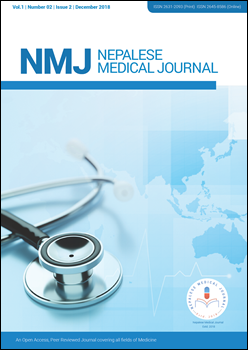Study on Correlation between Serum Prostate Specific Antigen and Various Prostatic Pathology
DOI:
https://doi.org/10.3126/nmj.v1i2.21579Keywords:
Benign, Carcinoma, Hyperplasia, Prostate, Prostate specific antigenAbstract
Introduction: Prostatic enlargement that may due to any cause may give rise to bladder outlet obstruction. Prostatic specific antigen is the enzyme that is responsible for liquefaction of semen within a few minutes after it has clotted. Prostatic specific antigen is a widely used tumor marker for prostatic cancer. Prostatic specific antigen levels in the blood go up if the barrier between the lining epithelium and the blood stream is damaged. This study was done to determine the correlation between serum Prostatic specific antigen level and histological diagnosis in prostatic biopsy.
Material and Methods: This is a one year prospective study carried out in the Department of Pathology, Nobel Medical College from August 16, 2016 to August 15 2017. A total of 175 cases were included in the study. Patient Prostatic specific antigen level were noted and biopsy specimen was collected after operation. Histopathological examination was done and correlation between HPE diagnosis and serum Prostatic specific antigen level was done.
Results: Benign Prostatic Hyperplasia was the most common diagnosis that was encountered. Majority of the cases had a serum Prostatic specific antigen level less than 10 ng/ml. Serum Prostatic specific antigen level of more than 30 ng/ml was seen only in prostatic carcinoma.
Conclusions: Serum Prostatic specific antigen is organ specific but not a disease for prostate. It can be used to monitor the carcinoma of the prostate rather than the diagnosis of the carcinoma.
Downloads
Downloads
Published
How to Cite
Issue
Section
License
This license enables reusers to distribute, remix, adapt, and build upon the material in any medium or format, so long as attribution is given to the creator. The license allows for commercial use.
Copyright on any article published by Nepalese Medical Journal is retained by the author(s).
Authors grant Nepalese Medical Journal a license to publish the article and identify itself as the original publisher.
Authors also grant any third party the right to use the article freely as long as its integrity is maintained and its original authors, citation details and publisher are identified.




